Abstract
Cell-free extracts of Pseudomonas aeruginosa contain enzyme activities which reduce Fe(III) to Fe(II) when iron is provided in certain chelates, but not when the iron is uncomplexed. Iron reductase activities for two substrates, ferripyochelin and ferric citrate, appear to be separate enzymes because of differences in heat stabilities, in locations in fractions of cell-free extracts, in reductant specificity, and in apparent sizes during gel filtration chromatography. Ferric citrate iron reductase is an extremely labile activity found in the cytoplasmic fraction, and ferripyochelin iron reductase is a more stable activity found in the periplasmic as well as cytoplasmic fraction of extracts. A small amount of activity detectable in the membrane fraction seemed to be loosely associated with the membranes. Although both enzymes have highest activity reduced nicotinamide adenine dinucleotide, reduced glutathione also worked with ferripyochelin iron reductase. In addition, oxygen caused an irreversible loss of a percentage of the ferripyochelin iron reductase following sparge of reaction mixtures, whereas the reductase for ferric citrate was not appreciably affected by oxygen.
Full text
PDF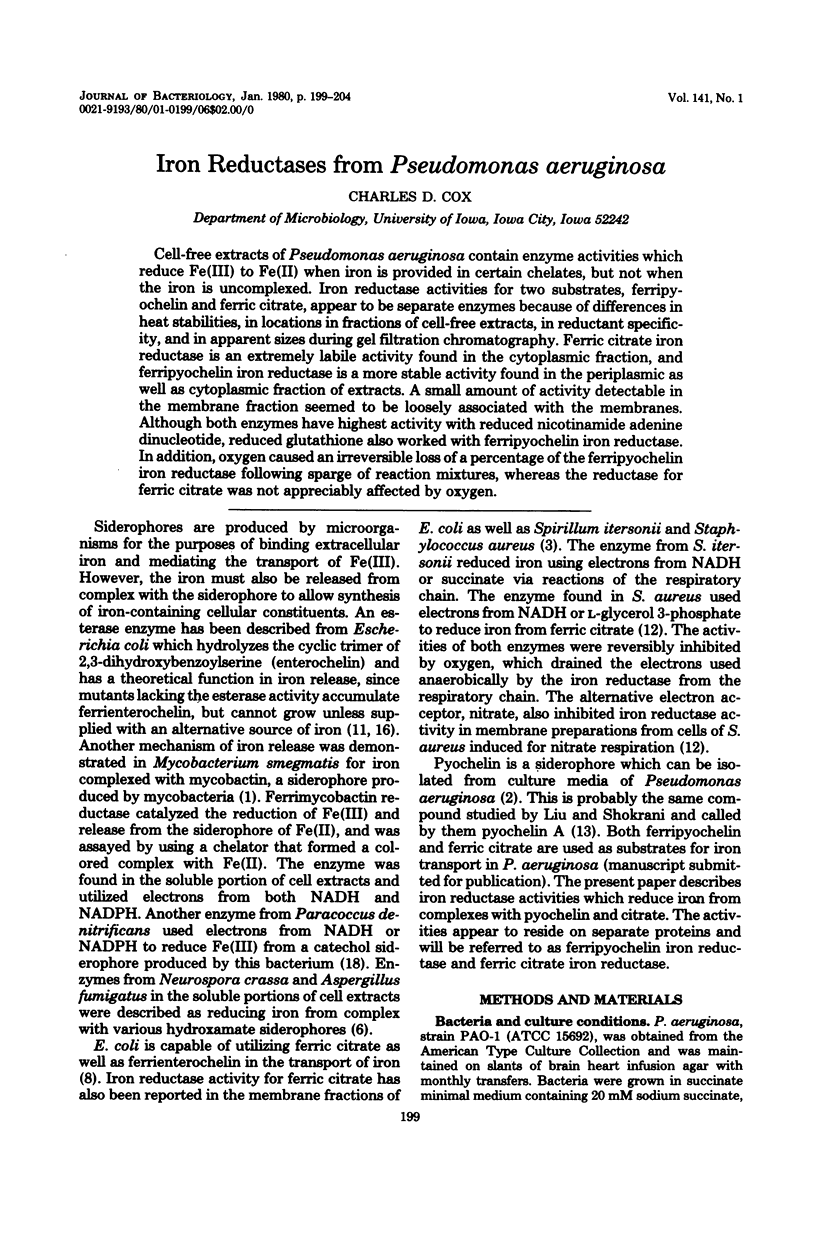
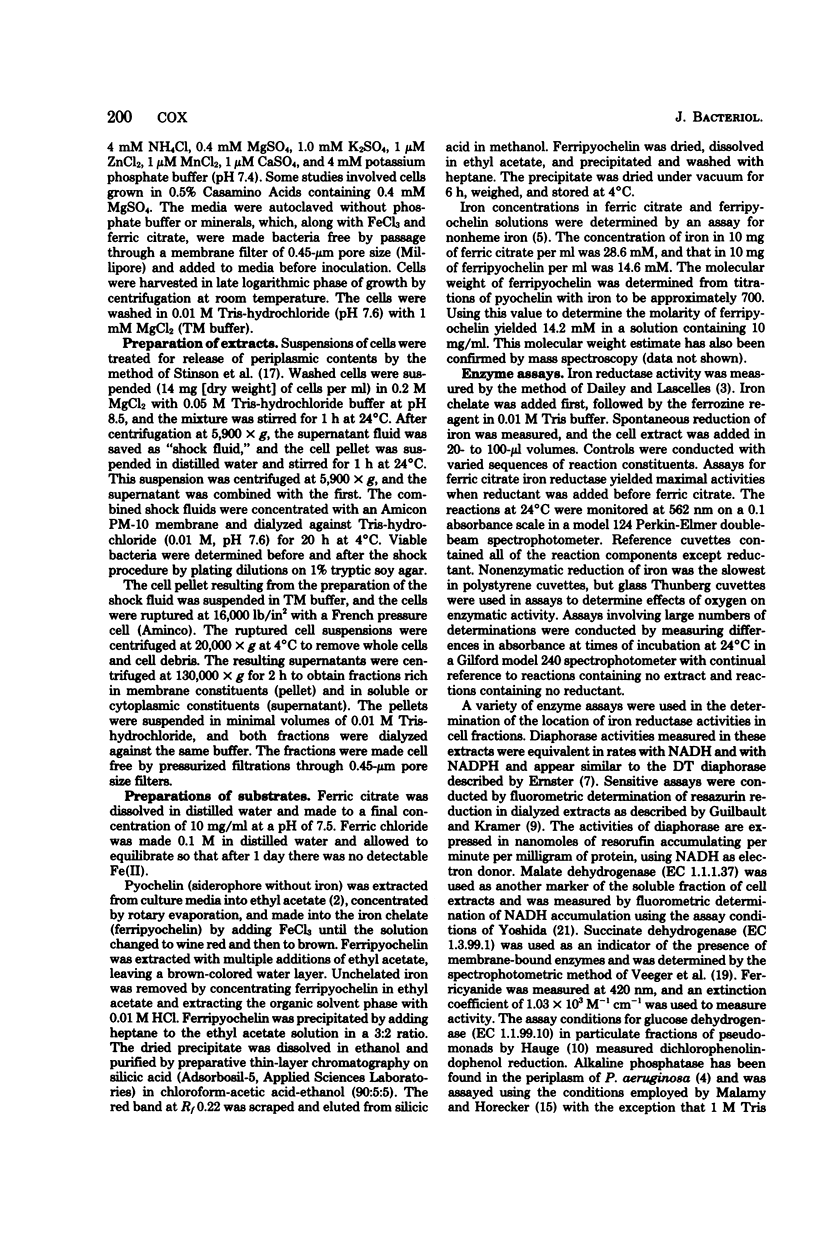
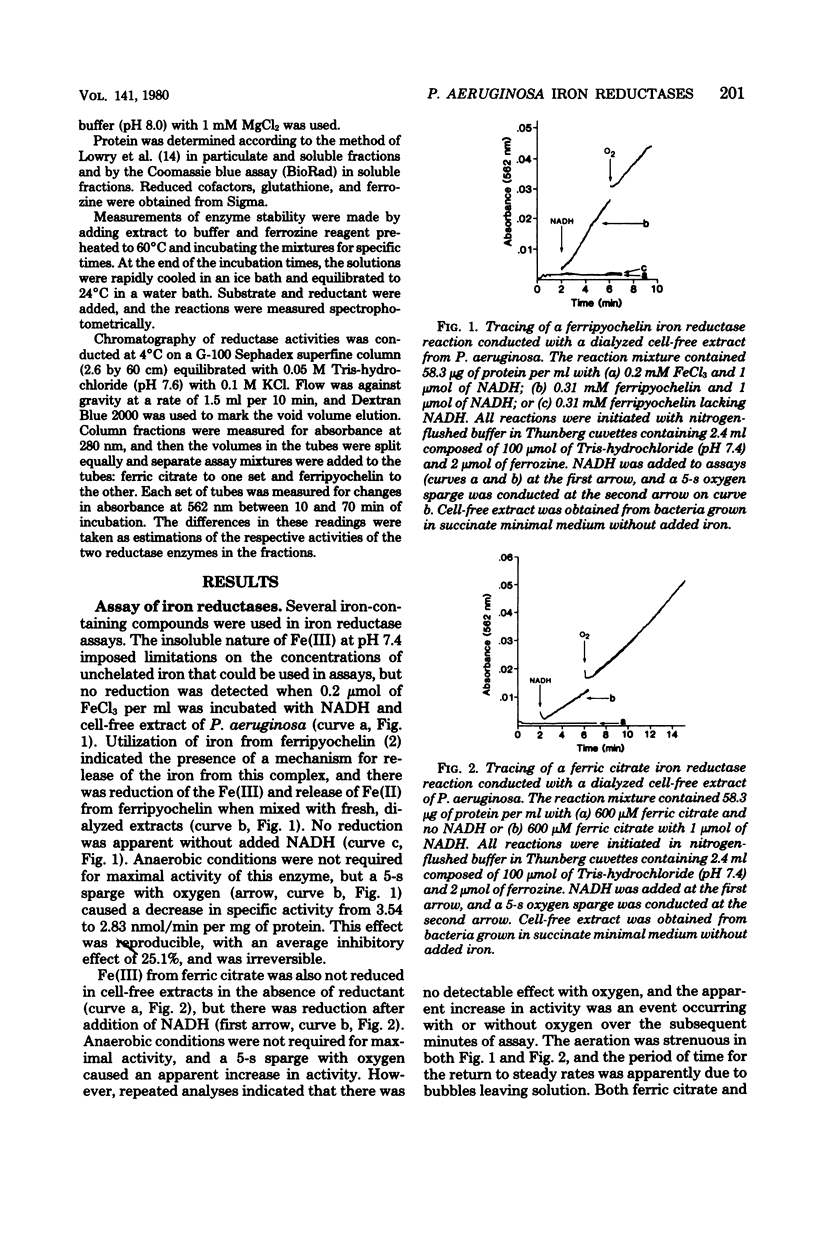
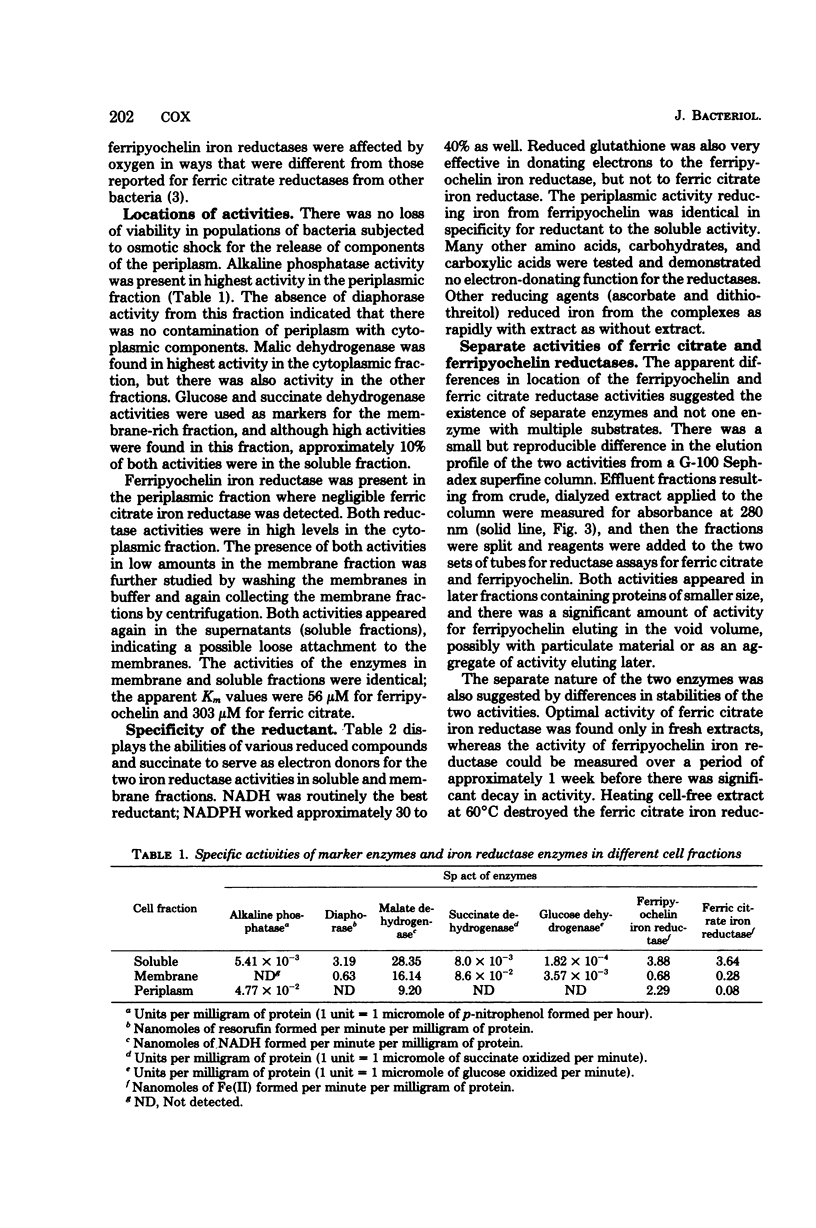
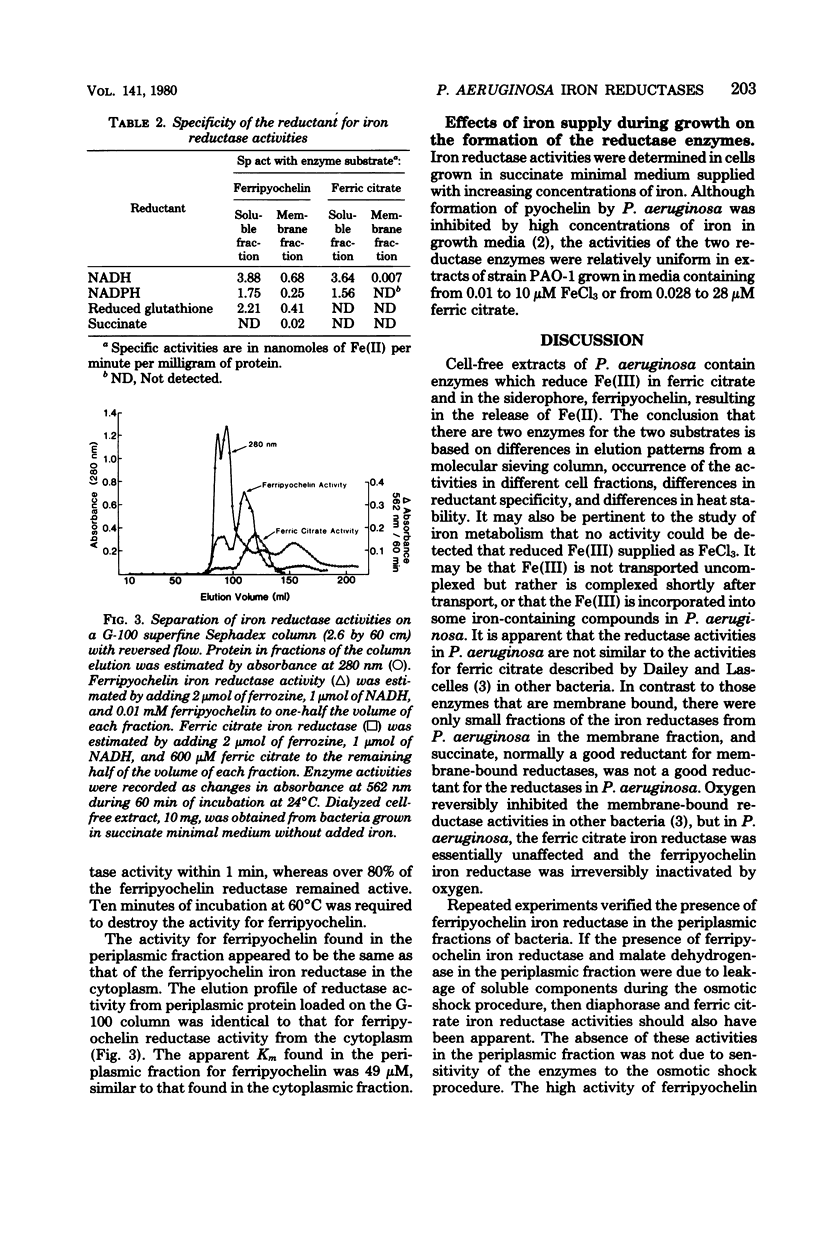
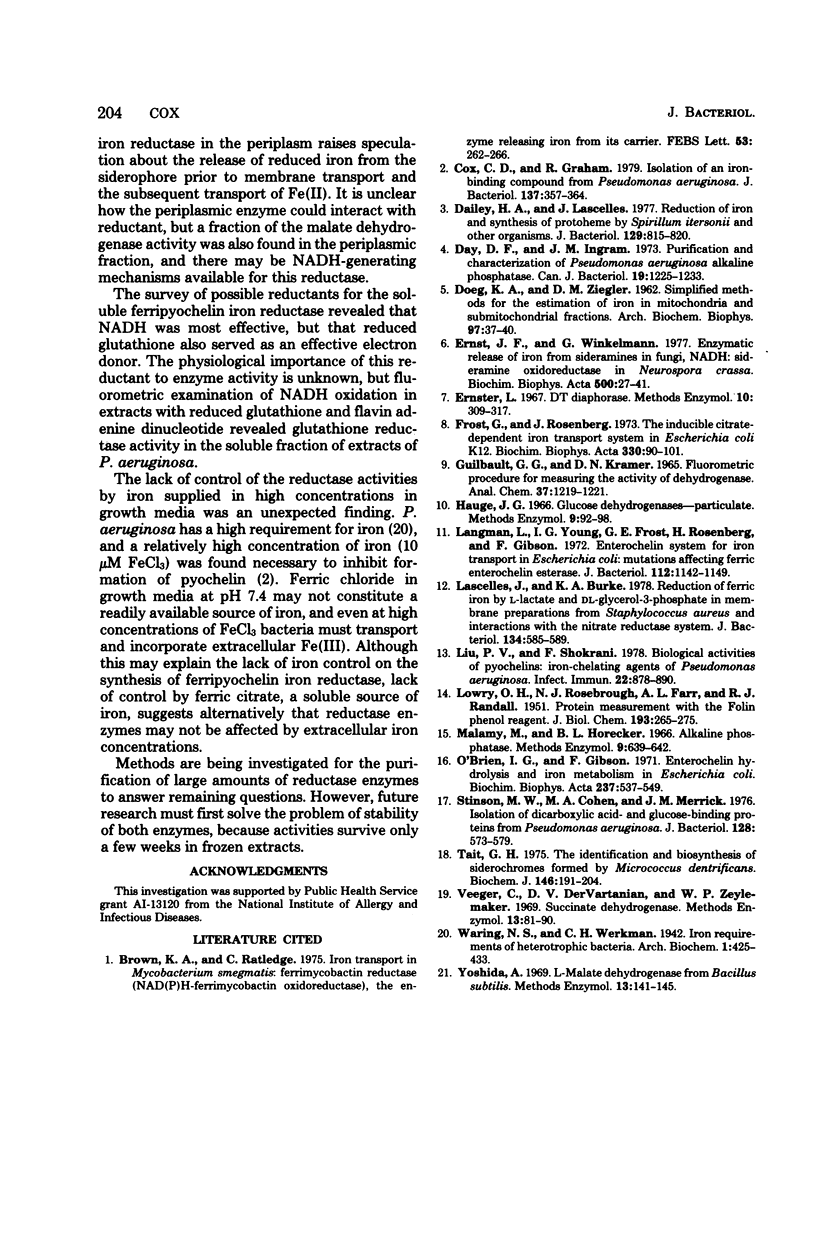
Selected References
These references are in PubMed. This may not be the complete list of references from this article.
- Brown K. A., Ratledge C. Iron transport in Mycobacterium smegmatis: ferrimycobactin reductase (nad(p)h:ferrimycobactin oxidoreductase), the enzyme releasing iron from its carrier. FEBS Lett. 1975 May 1;53(2):262–266. doi: 10.1016/0014-5793(75)80033-0. [DOI] [PubMed] [Google Scholar]
- Cox C. D., Graham R. Isolation of an iron-binding compound from Pseudomonas aeruginosa. J Bacteriol. 1979 Jan;137(1):357–364. doi: 10.1128/jb.137.1.357-364.1979. [DOI] [PMC free article] [PubMed] [Google Scholar]
- DOEG K. A., ZIEGLER D. M. Simplified methods for the estimation of iron in mitochondria and submitochondrial fractions. Arch Biochem Biophys. 1962 Apr;97:37–40. doi: 10.1016/0003-9861(62)90041-3. [DOI] [PubMed] [Google Scholar]
- Dailey H. A., Jr, Lascelles J. Reduction of iron and synthesis of protoheme by Spirillum itersonii and other organisms. J Bacteriol. 1977 Feb;129(2):815–820. doi: 10.1128/jb.129.2.815-820.1977. [DOI] [PMC free article] [PubMed] [Google Scholar]
- Day D. F., Ingram J. M. Purification and characterization of Pseudomonas aeruginosa alkaline phosphatase. Can J Microbiol. 1973 Oct;19(10):1225–1233. doi: 10.1139/m73-198. [DOI] [PubMed] [Google Scholar]
- Ernst J. F., Winkelmann G. Enzymatic release of iron from sideramines in fungi. NADH:sideramine oxidoreductase in Neurospora crassa. Biochim Biophys Acta. 1977 Nov 7;500(1):27–41. doi: 10.1016/0304-4165(77)90043-5. [DOI] [PubMed] [Google Scholar]
- Frost G. E., Rosenberg H. The inducible citrate-dependent iron transport system in Escherichia coli K12. Biochim Biophys Acta. 1973 Nov 30;330(1):90–101. doi: 10.1016/0005-2736(73)90287-3. [DOI] [PubMed] [Google Scholar]
- GUILBAULT G. G., KRAMER D. N. FLUOROMETRIC PROCEDURE FOR MEASURING THE ACTIVITY OF DEHYDROGENASES. Anal Chem. 1965 Sep;37:1219–1221. doi: 10.1021/ac60229a011. [DOI] [PubMed] [Google Scholar]
- LOWRY O. H., ROSEBROUGH N. J., FARR A. L., RANDALL R. J. Protein measurement with the Folin phenol reagent. J Biol Chem. 1951 Nov;193(1):265–275. [PubMed] [Google Scholar]
- Langman L., Young I. G., Frost G. E., Rosenberg H., Gibson F. Enterochelin system of iron transport in Escherichia coli: mutations affecting ferric-enterochelin esterase. J Bacteriol. 1972 Dec;112(3):1142–1149. doi: 10.1128/jb.112.3.1142-1149.1972. [DOI] [PMC free article] [PubMed] [Google Scholar]
- Lascelles J., Burke K. A. Reduction of ferric iron by L-lactate and DL-glycerol-3-phosphate in membrane preparations from Staphylococcus aureus and interactions with the nitrate reductase system. J Bacteriol. 1978 May;134(2):585–589. doi: 10.1128/jb.134.2.585-589.1978. [DOI] [PMC free article] [PubMed] [Google Scholar]
- Liu P. V., Shokrani F. Biological activities of pyochelins: iron-chelating agents of Pseudomonas aeruginosa. Infect Immun. 1978 Dec;22(3):878–890. doi: 10.1128/iai.22.3.878-890.1978. [DOI] [PMC free article] [PubMed] [Google Scholar]
- O'Brien I. G., Cox G. B., Gibson F. Enterochelin hydrolysis and iron metabolism in Escherichia coli. Biochim Biophys Acta. 1971 Jun 22;237(3):537–549. doi: 10.1016/0304-4165(71)90274-1. [DOI] [PubMed] [Google Scholar]
- Stinson M. W., Cohen M. A., Merrick J. M. Isolation of dicarboxylic acid- and glucose-binding proteins from Pseudomonas aeruginosa. J Bacteriol. 1976 Nov;128(2):573–579. doi: 10.1128/jb.128.2.573-579.1976. [DOI] [PMC free article] [PubMed] [Google Scholar]
- Tait G. H. The identification and biosynthesis of siderochromes formed by Micrococcus denitrificans. Biochem J. 1975 Jan;146(1):191–204. doi: 10.1042/bj1460191. [DOI] [PMC free article] [PubMed] [Google Scholar]


